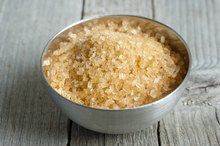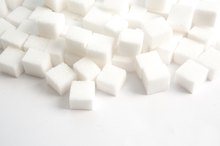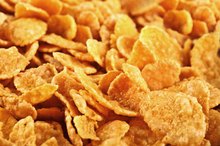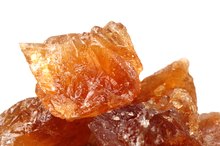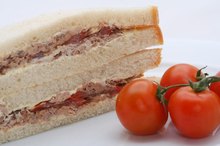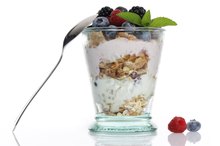Yeast Metabolism With Glucose
Yeast are fungal organisms that can feed on a number of different nutrients, but readily metabolize glucose, a kind of sugar. They have the ability to metabolize glucose with or without oxygen, and the mechanism of metabolism determines the products formed. People use yeast to produce certain foods, including baked goods and alcoholic beverages.
Glucose
Glucose is a type of carbohydrate, which is a compound of carbon, oxygen and hydrogen. Specifically, glucose is a monosaccharide, which means "single sugar unit." Monosaccharides can occur in nature on their own or can be combined into larger carbohydrates. Humans use glucose as a major cellular fuel, and yeast do as well; in both cases, it's an important source of energy.
- Glucose is a type of carbohydrate, which is a compound of carbon, oxygen and hydrogen.
- Specifically, glucose is a monosaccharide, which means "single sugar unit."
Aerobic Metabolism
What is the Complete Oxidation of a Glucose Molecule?
Learn More
While there are many different species of yeast and they differ metabolically from one another, all can metabolize glucose aerobically, meaning "with oxygen." This results in the production of a large quantity of energy, as well as the waste products carbon dioxide and water. These are the same waste products that you form when you metabolize glucose for energy. In general, if oxygen is present, yeast will use it to process glucose, since this is much more efficient than metabolizing glucose without oxygen.
- While there are many different species of yeast and they differ metabolically from one another, all can metabolize glucose aerobically, meaning "with oxygen."
- In general, if oxygen is present, yeast will use it to process glucose, since this is much more efficient than metabolizing glucose without oxygen.
Anaerobic Metabolism
If there isn't oxygen present, some species of yeast can survive nevertheless, and can metabolize glucose through an alternate pathway that results in the formation of significantly less energy and different end products. The products of anaerobic -- meaning "without oxygen" -- metabolism of glucose by yeast are carbon dioxide and ethanol, which is drinking alcohol. Humans don't produce the same products during anerobic metabolism of glucose; we produce lactic acid instead.
Use
Foods Containing Glucose or Fructose
Learn More
The products of glucose metabolism by yeast are useful in making certain foods. For instance, when you bake yeast bread, the yeast are breaking down glucose and producing carbon dioxide, which gets trapped in the dough matrix in small bubbles. These expand during baking, and are responsible for the light texture of risen bread. The ethanol made by yeast shows up in wine and beer, both of which depend upon anaerobic breakdown of glucose by yeast.
- The products of glucose metabolism by yeast are useful in making certain foods.
- The ethanol made by yeast shows up in wine and beer, both of which depend upon anaerobic breakdown of glucose by yeast.
Related Articles
References
- Biochemistry; Reginald Garrett, Ph.D. and Charles Grisham, Ph.D.
- Biochemistry; Mary Campbell, Ph.D. and Shawn Farrell, Ph.D.
- Centers for Disease Control and Prevention. Vaginal Candidiasis. Updated April 12, 2019.
- Rodrigues CF, Rodrigues ME, Henriques M. Candida sp. Infections in Patients with Diabetes Mellitus. J Clin Med. 2019;8(1):76. doi:10.3390/jcm8010076
- Centers for Disease Control and Prevention. Cancer Patients and Fungal Infections. Updated January 25, 2017.
- U.S. Department of Health & Human Services. Office on Women's Health. Vaginal yeast infections. Updated April 1, 2019.
- Cancer Patients and Fungal Infections. Centers for Disease Control and Prevention. https://www.cdc.gov/fungal/infections/cancer-patients.html.
- Vaginal Yeast Infections. Office of Women's Health, U.S. Department of Health and Human Services. https://www.womenshealth.gov/a-z-topics/vaginal-yeast-infections.
- Atabek ME, Akyurek N, Eklioglu BS. Frequency of Vagınal Candida Colonization and Relationship between Metabolic Parameters in Children with Type 1 Diabetes Mellitus. Journal of Pediatric and Adolescent Gynecology. October 2013;26(5):257-260. doi:10.1016/j.jpag.2013.03.016.
- Sobel JD. Candida vulvovaginitis: Clinical manifestations and diagnosis. UpToDate. https://www.uptodate.com/contents/candida-vulvovaginitis-clinical-manifestations-and-diagnosis.
- Weintrob AC, Sexton DJ. Susceptibility to Infections in Persons With Diabetes Mellitus. UpToDate. https://www.uptodate.com/contents/susceptibility-to-infections-in-persons-with-diabetes-mellitus.
Writer Bio
Kirstin Hendrickson is a writer, teacher, coach, athlete and author of the textbook "Chemistry In The World." She's been teaching and writing about health, wellness and nutrition for more than 10 years. She has a Bachelor of Science in zoology, a Bachelor of Science in psychology, a Master of Science in chemistry and a doctoral degree in bioorganic chemistry.

